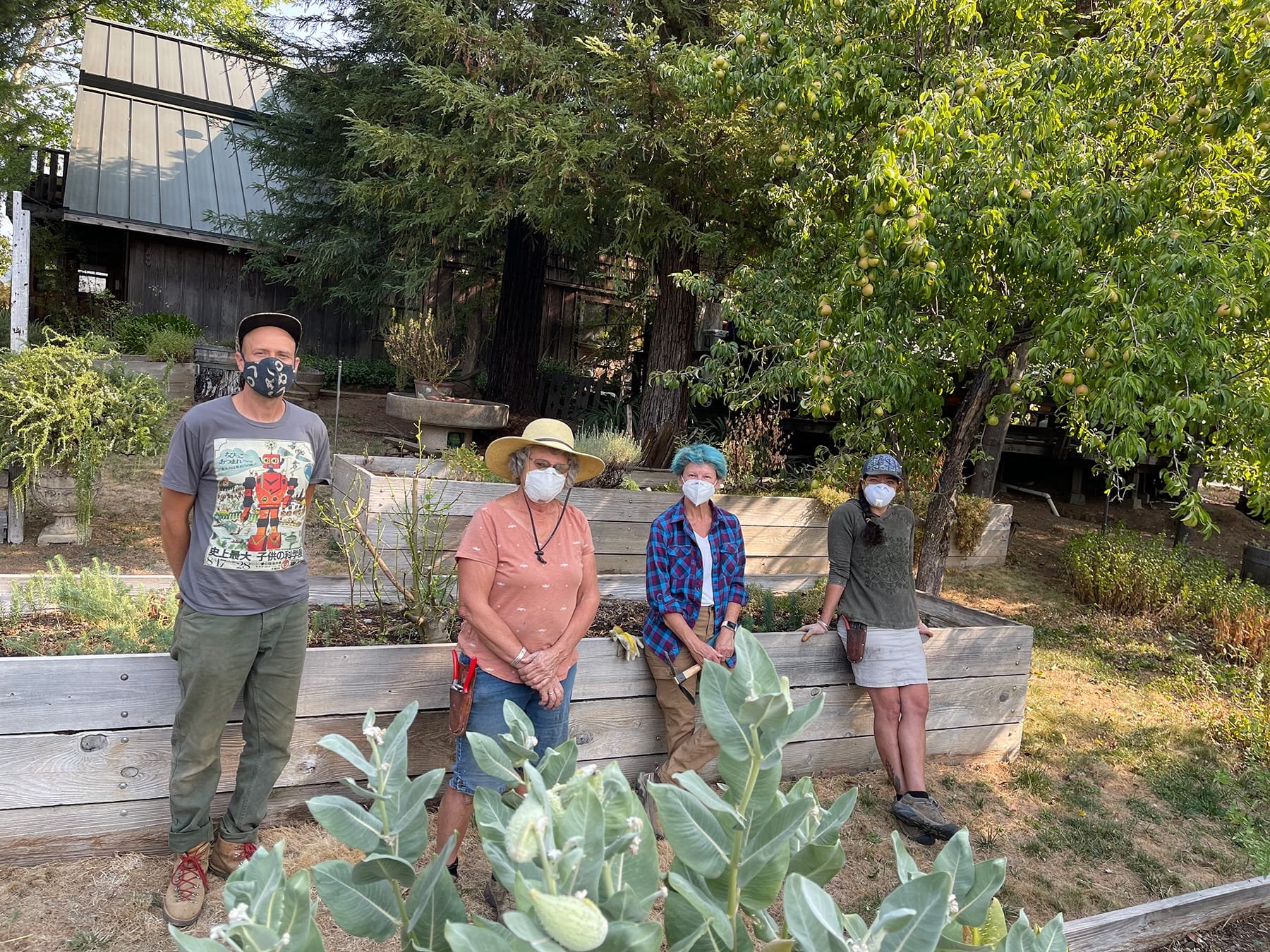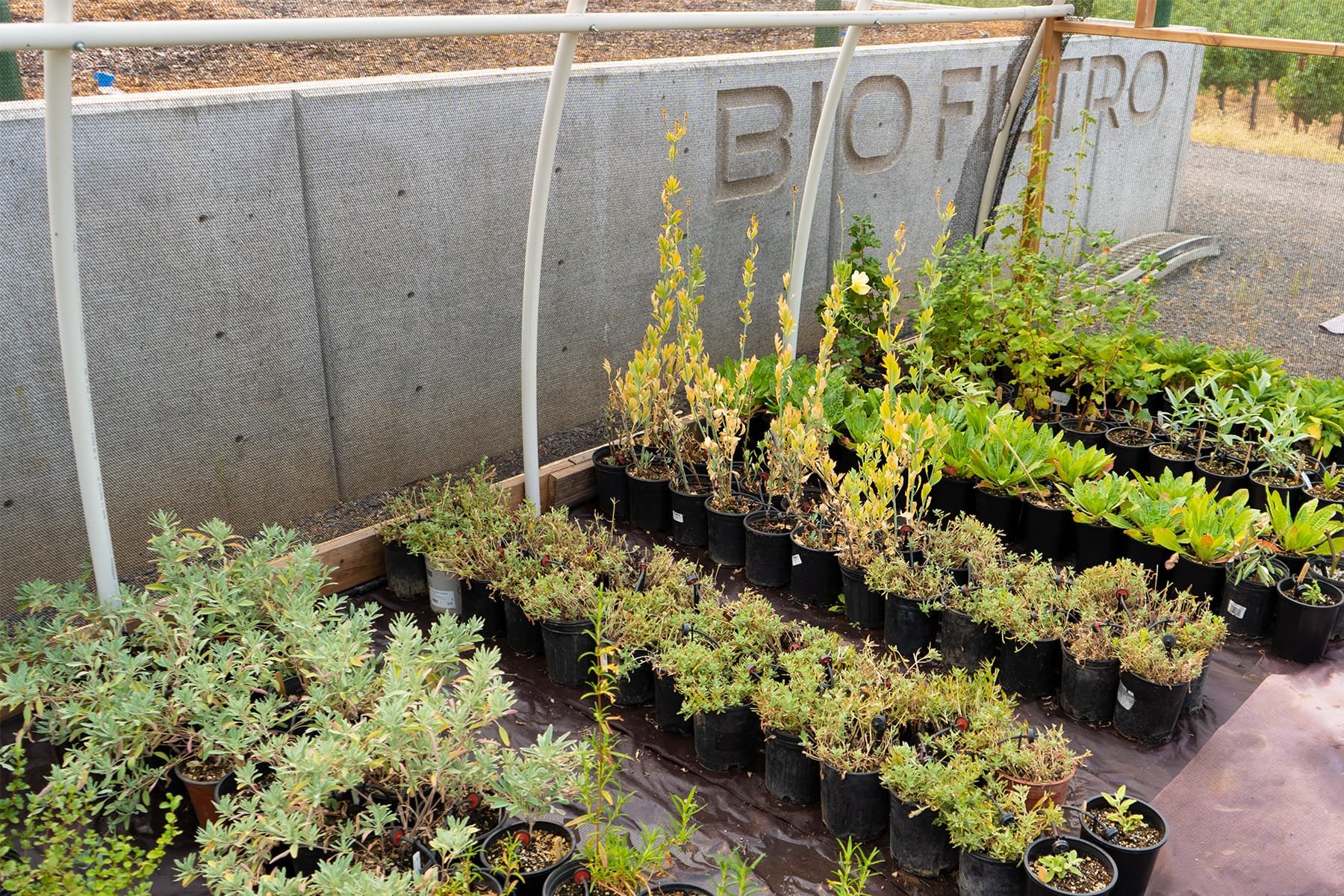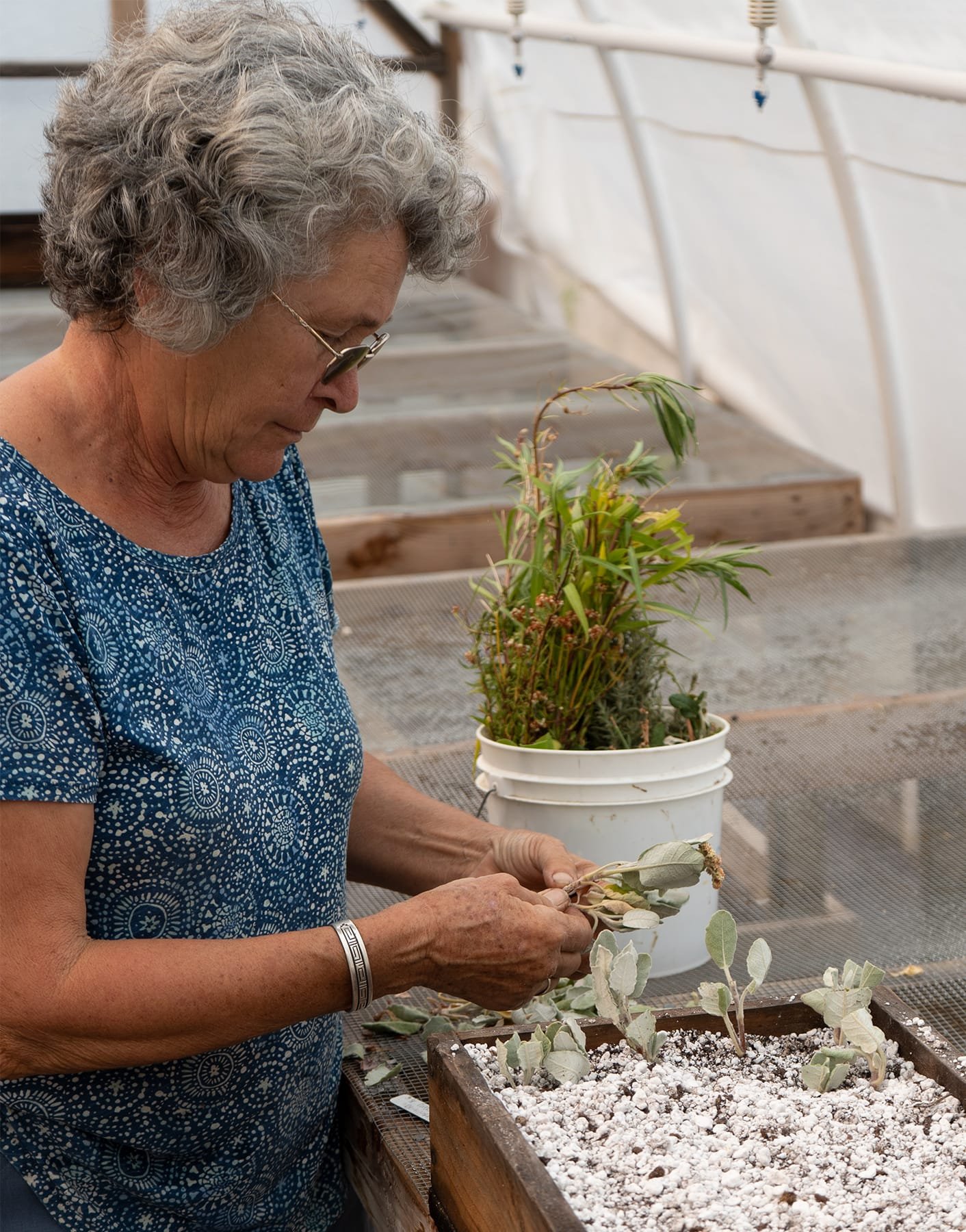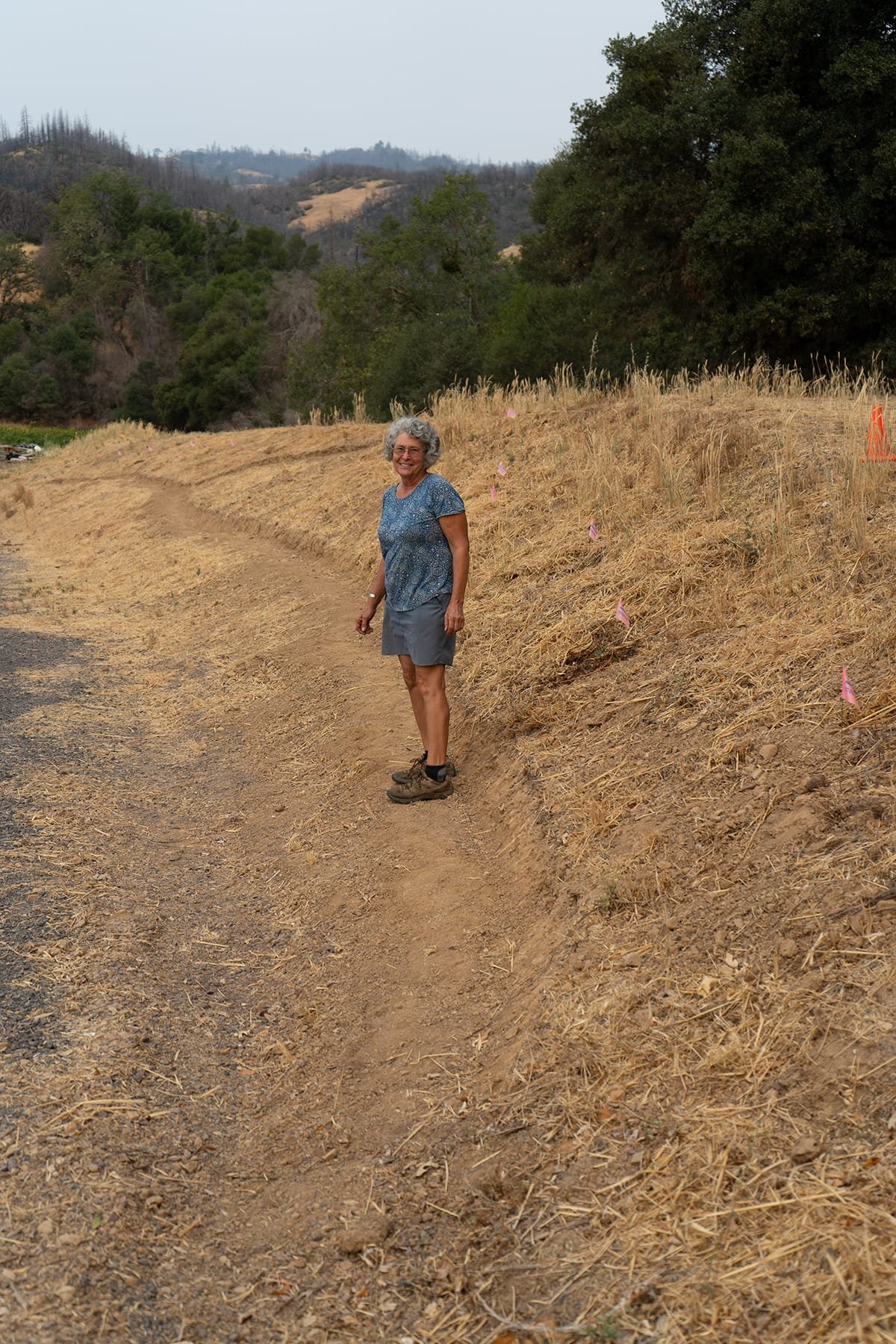Native Plants for Native Insects
A New Landscaping Project at Frey Vineyards
Andrew, Carolyn, Monet, and Jessica – Gardeners extraordinaire at Frey Vineyards!
A central focus of Biodynamic Farming is to keep in or restore to at least 10% of a farm’s native vegetation. This provides habitat for wildlife and insect species that together create a healthy and resilient ecosystem. In turn, the presence of these animals, insects, plants and microorganisms help protect the crops from harmful predators, parasites and diseases. Frey Vineyards is working to reestablish native vegetation on a large berm at the new winery. The berm will be part of a nature trail where visitors can enjoy the beauty of our vineyard nestled in the surrounding oak woodland, learn about key plant communities and the wildlife that they support.
Native Plants for Native Insects growing at Frey Vineyards
The plants chosen for this project will provide habitat and forage for pollinators and birds; create a landscaped backdrop for the winery; and provide privacy and a shield for our neighbors. These plants are being propagated and grown out in a shade house and hoop house at the new winery site. Last fall, acorns were collected from favorite heritage oaks growing at the original winery site and were planted on the berm with the first rains. This summer these pioneering trees are now a few inches tall. They will be the backbone of the new plantings on the berm. Oaks are the superfood of the plant kingdom. “A mature oak supports thousands of caterpillars, making it a foraging heaven for birds and other animals. In 87% of U.S. counties, oaks feed more moth and butterfly caterpillars than any other type of plant.” (From “The Chickadee’s Guide to Gardening“ by Doug Tallamy).
Carolyn propagating native plants for native insects
Native flowering shrubs are being grown out in 1-gallon pots and are ready to be field planted with the coming fall rains. The plants selected are those that will provide an extended period of bloom throughout the growing season, giving our insect visitors an abundant and varied source of nectar and pollen. We are also growing out three species of milkweed native to Mendocino County. Milkweed is the only host plant of Monarch butterfly larvae and it is also a favorite nectar and pollen plant for many insects. This fall we will seed flats of perennial bunch grasses native to Mendocino County. The grasses will be interplanted with native wildflowers to create meadow areas. Together, the grasses and wildflowers will provide displays of color and visual interest throughout the seasons. The grasses will help stabilize the bank and protect it from wind and water erosion and they also provide overwintering shelter for many species of bees, bumble bees, other insects, as well as nesting materials for birds.
When we talk about protecting pollinators and butterflies, perhaps the first species that come to mind are the European honeybee and the Monarch Butterfly. These two beloved species have seen devastating losses over the past several decades; however, California has over 16,000 identified species of bees and over 1,177 species of moths and butterflies. Many of these fragile creatures are suffering from the same environmental threats as the honeybees and Monarch butterflies. The European honeybee is essential for the pollination of many of our food crops, especially those grown in large monocrop systems, because the hives can be moved into a crop during flowering and fruit set and moved on to another crop after the bloom has passed. The pollination services of the European honeybee in large agricultural systems are necessary because the native pollinators are unable to survive in these mono cropped systems. There is not an ongoing source of nectar and pollen in weed free mono crops environments to support and sustain their populations and the pesticides used are as toxic to beneficial insects as they are to the target pest. However, our reliance on the European honeybee has caused significant stress to these essential creatures. Bees, like us, need a balanced and varied diet. When they are moved from crop to crop, they are getting mostly one type of food at a time which leads to nutrient deficiencies. Also, there may be toxic pesticide residues on the crop, in field irrigation water that the bees drink, or in adjacent fields that the bees fly to. These toxins can be fatal on contact, diminishing the population of foraging bees. Sub-lethal doses are brought back to the colony where they may build up in the wax honeycomb, in much the same way as they build up in the fatty tissues of mammals. The accumulation of these toxins cause ongoing stress to the colony. The bees also go through a stressful period of reorientation each time they are moved to a new field throughout the pollination season. They need to learn where the flowers and water sources are and must slowly reorient themselves to the new landscape so they can find their way home. Also, some foraging bees are often left behind with each move, diminishing the foraging workers. Finally, colonies of bees are transported into crops for pollination services from great distances and diseases and parasites can spread rapidly between colonies during these concentrated situations.
Native plants for native insects, like this young oak
In the same way that our attention has focused on the plight of the honeybee, so too have we focused on the loss of our exquisite Monarch butterflies. These remarkable creatures make up two groups. The Western Monarchs migrate from the coast of central California throughout states west of the Rocky Mountains. The Eastern Monarchs migrate from central Mexico up to the northern plains of the United States and Canada east of the Rocky Mountains. Loss of habitat, loss of milkweed species, climate change, pesticides and diseases, have all contributed to the devasting decline of these magnificent butterflies.
Native plants for native insects, like these small starts, are growing at Frey
How can we farm and garden in ways that protect and nurture these essential pollinators? At Frey Vineyards we strive to create healthy, viable ecosystems on the farm. For example, many bird species rely on insects to feed their young, so over 100 bird nest boxes are distributed throughout our vineyards. Blue Birds, Tree Swallows, Ash Throated Flycatchers, among other species, use the boxes and they help keep insect pest populations down. Planting local, native plant species also helps to foster healthy farm and garden ecosystems. Insects have evolved with specific plant communities, using a variety of plants that are native to one’s region and choosing a selection of plants that provide a continual bloom throughout the growing season will provide the best food source to attract and sustain these beneficial creatures. Making a commitment to not use pesticides or using only the least toxic methods possible at only the most vulnerable stages of a pest’s lifecycle is also essential. At Frey Vineyards, farming practices follow the strict USDA Organic Farming and Demeter Biodynamic Farming standards. Regulations governing pesticide use in both organizations prohibit the use of any synthetic compound and best practice guidelines further require that judicious monitoring take place before any control measures are taken. If it is determined that there is a significant threat to the crop then the least toxic and least broad spectrum measures available to organic growers are used to control a pest.
Native plants for native insects, like these grown at Frey Vineyards to add to our new winery landscape
U.C. Davis has an informative website to help you make the decisions about these least toxic pest control options. Provide safe, undisturbed habitat for these insects. Many bees and bumble bees build their nests in the ground. Leave bare patches of soil, in areas that drain well, for them to nest in. Some bees lay their eggs and provide a nest for the developing larvae in the hollow stems of plants. Leave these plants standing over the winter and cut them back later, during the following year. This will give the developing larvae time to mature and emerge as adult bees. Provide a year-round source of drinking water. Place stones in a shallow basin so the insects can safely drink without falling in and keep their water fresh and clean. Learn which species you have in your area and focus on providing habitat and food sources for them. There are many excellent websites to help you learn about plants and pollinators native to your area.
Carolyn Brown at the new winery site, preparing the area for transplanting native plants for native insects
The California Native Plant Society has information on plants and their respective communities and the wildlife that they support.
The Xerces Society has a wealth of information on gardening practices that support butterflies and pollinators.
Butterflies and Moths of North America is a data base that has photos to help you identify moths and butterflies in your area as well as helpful information on host plants you can plant for each species.
We look forward to having you visit when we are once again open to the public. Until then, happy bee and butterfly gardening!
Carolyn Brown
Lead Gardener, Frey Vineyards Ltd.







